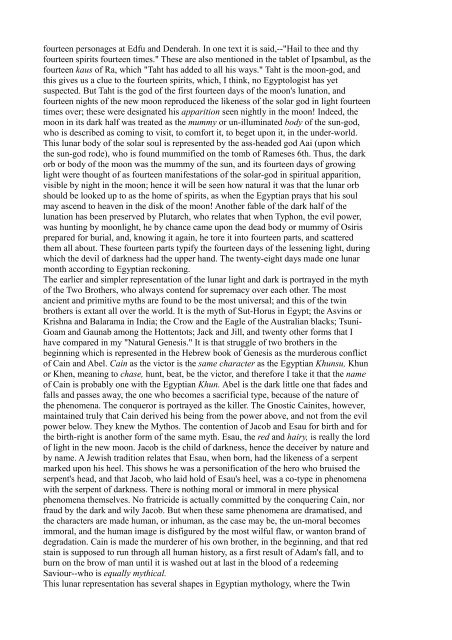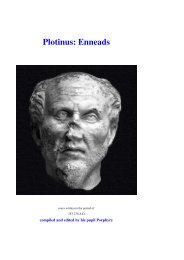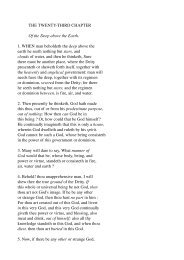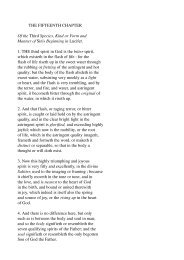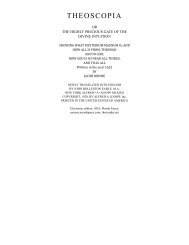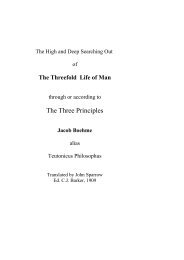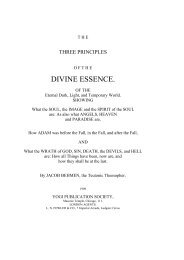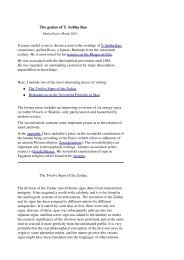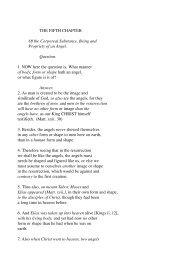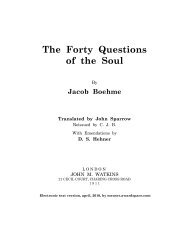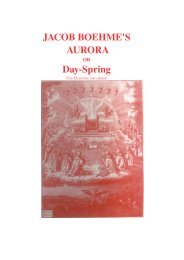Gerald Massey's Lectures - Society in evolution - Awardspace
Gerald Massey's Lectures - Society in evolution - Awardspace
Gerald Massey's Lectures - Society in evolution - Awardspace
You also want an ePaper? Increase the reach of your titles
YUMPU automatically turns print PDFs into web optimized ePapers that Google loves.
fourteen personages at Edfu and Denderah. In one text it is said,--"Hail to thee and thy<br />
fourteen spirits fourteen times." These are also mentioned <strong>in</strong> the tablet of Ipsambul, as the<br />
fourteen kaus of Ra, which "Taht has added to all his ways." Taht is the moon-god, and<br />
this gives us a clue to the fourteen spirits, which, I th<strong>in</strong>k, no Egyptologist has yet<br />
suspected. But Taht is the god of the first fourteen days of the moon's lunation, and<br />
fourteen nights of the new moon reproduced the likeness of the solar god <strong>in</strong> light fourteen<br />
times over; these were designated his apparition seen nightly <strong>in</strong> the moon! Indeed, the<br />
moon <strong>in</strong> its dark half was treated as the mummy or un-illum<strong>in</strong>ated body of the sun-god,<br />
who is described as com<strong>in</strong>g to visit, to comfort it, to beget upon it, <strong>in</strong> the under-world.<br />
This lunar body of the solar soul is represented by the ass-headed god Aai (upon which<br />
the sun-god rode), who is found mummified on the tomb of Rameses 6th. Thus, the dark<br />
orb or body of the moon was the mummy of the sun, and its fourteen days of grow<strong>in</strong>g<br />
light were thought of as fourteen manifestations of the solar-god <strong>in</strong> spiritual apparition,<br />
visible by night <strong>in</strong> the moon; hence it will be seen how natural it was that the lunar orb<br />
should be looked up to as the home of spirits, as when the Egyptian prays that his soul<br />
may ascend to heaven <strong>in</strong> the disk of the moon! Another fable of the dark half of the<br />
lunation has been preserved by Plutarch, who relates that when Typhon, the evil power,<br />
was hunt<strong>in</strong>g by moonlight, he by chance came upon the dead body or mummy of Osiris<br />
prepared for burial, and, know<strong>in</strong>g it aga<strong>in</strong>, he tore it <strong>in</strong>to fourteen parts, and scattered<br />
them all about. These fourteen parts typify the fourteen days of the lessen<strong>in</strong>g light, dur<strong>in</strong>g<br />
which the devil of darkness had the upper hand. The twenty-eight days made one lunar<br />
month accord<strong>in</strong>g to Egyptian reckon<strong>in</strong>g.<br />
The earlier and simpler representation of the lunar light and dark is portrayed <strong>in</strong> the myth<br />
of the Two Brothers, who always contend for supremacy over each other. The most<br />
ancient and primitive myths are found to be the most universal; and this of the tw<strong>in</strong><br />
brothers is extant all over the world. It is the myth of Sut-Horus <strong>in</strong> Egypt; the Asv<strong>in</strong>s or<br />
Krishna and Balarama <strong>in</strong> India; the Crow and the Eagle of the Australian blacks; Tsuni-<br />
Goam and Gaunab among the Hottentots; Jack and Jill, and twenty other forms that I<br />
have compared <strong>in</strong> my "Natural Genesis." It is that struggle of two brothers <strong>in</strong> the<br />
beg<strong>in</strong>n<strong>in</strong>g which is represented <strong>in</strong> the Hebrew book of Genesis as the murderous conflict<br />
of Ca<strong>in</strong> and Abel. Ca<strong>in</strong> as the victor is the same character as the Egyptian Khunsu, Khun<br />
or Khen, mean<strong>in</strong>g to chase, hunt, beat, be the victor, and therefore I take it that the name<br />
of Ca<strong>in</strong> is probably one with the Egyptian Khun. Abel is the dark little one that fades and<br />
falls and passes away, the one who becomes a sacrificial type, because of the nature of<br />
the phenomena. The conqueror is portrayed as the killer. The Gnostic Ca<strong>in</strong>ites, however,<br />
ma<strong>in</strong>ta<strong>in</strong>ed truly that Ca<strong>in</strong> derived his be<strong>in</strong>g from the power above, and not from the evil<br />
power below. They knew the Mythos. The contention of Jacob and Esau for birth and for<br />
the birth-right is another form of the same myth. Esau, the red and hairy, is really the lord<br />
of light <strong>in</strong> the new moon. Jacob is the child of darkness, hence the deceiver by nature and<br />
by name. A Jewish tradition relates that Esau, when born, had the likeness of a serpent<br />
marked upon his heel. This shows he was a personification of the hero who bruised the<br />
serpent's head, and that Jacob, who laid hold of Esau's heel, was a co-type <strong>in</strong> phenomena<br />
with the serpent of darkness. There is noth<strong>in</strong>g moral or immoral <strong>in</strong> mere physical<br />
phenomena themselves. No fratricide is actually committed by the conquer<strong>in</strong>g Ca<strong>in</strong>, nor<br />
fraud by the dark and wily Jacob. But when these same phenomena are dramatised, and<br />
the characters are made human, or <strong>in</strong>human, as the case may be, the un-moral becomes<br />
immoral, and the human image is disfigured by the most wilful flaw, or wanton brand of<br />
degradation. Ca<strong>in</strong> is made the murderer of his own brother, <strong>in</strong> the beg<strong>in</strong>n<strong>in</strong>g, and that red<br />
sta<strong>in</strong> is supposed to run through all human history, as a first result of Adam's fall, and to<br />
burn on the brow of man until it is washed out at last <strong>in</strong> the blood of a redeem<strong>in</strong>g<br />
Saviour--who is equally mythical.<br />
This lunar representation has several shapes <strong>in</strong> Egyptian mythology, where the Tw<strong>in</strong>


